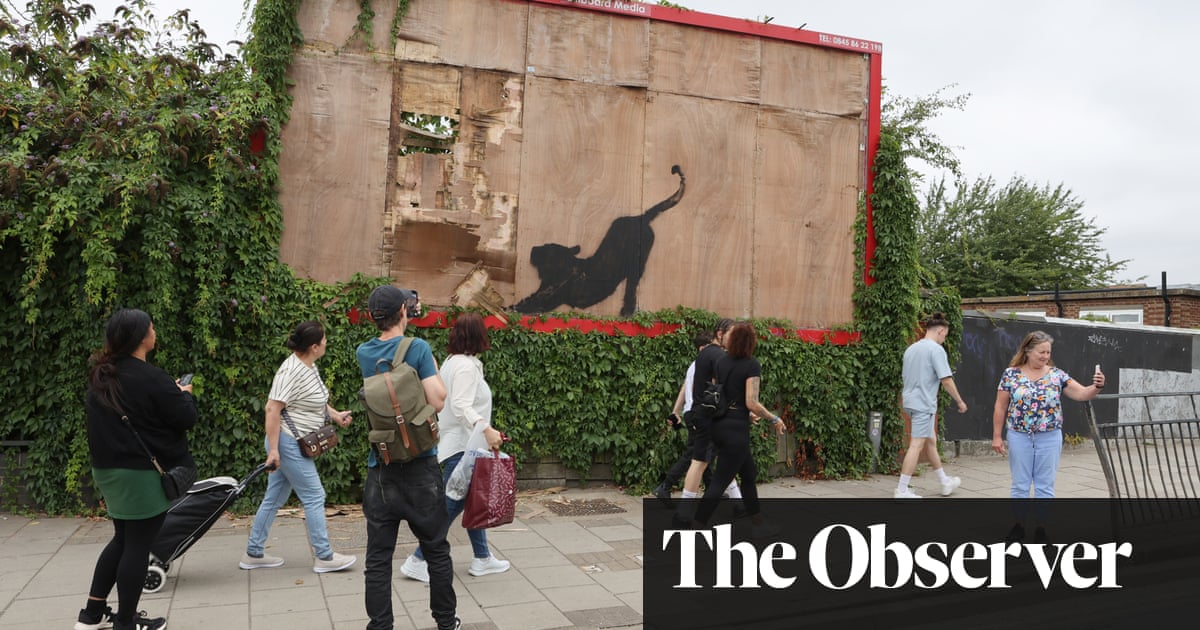A big cat by Banksy appeared briefly, stretching in the morning sun, on a bare advertising hoarding on Edgware Road in Cricklewood, north-west London, on Saturday. A few hours later it had gone, removed by contractors who feared it would be ripped down.
The anonymous artist known as Banksy, who confirmed the image was his at lunchtime on Saturday, also promised a little more summer fun to come.
A seventh image may shortly materialise in another surprising location, the Observer has learned. London residents should then keep their eyes peeled, a spokesperson suggested, for a few days longer.
For a week now, the streets of the capital have been populated by a string of unusual animal sightings, courtesy of Banksy, including pelicans, a goat and a trio of monkeys.
The artist’s vision is simple: the latest street art has been designed to cheer up the public during a period when the news headlines have been bleak, and light has often been harder to spot than shade.
Banksy’s hope, it is understood, is that the uplifting works cheer people with a moment of unexpected amusement, as well as to gently underline the human capacity for creative play, rather than for destruction and negativity.
Some recent theorising about the deeper significance of each new image has been way too involved, Banksy’s support organisation, Pest Control Office, has indicated.
When a goat teetering on a precipice first appeared on Monday near Kew Bridge, in south-west London, some thought it might be a symbol of humanity’s folly. Others speculated it might be a visual pun on the idea of the goat, now standing for “greatest of all time” in popular parlance.
On Tuesday, two silhouetted elephant heads popped up, their trunks reaching out to each other through the bricked-up windows of a house in Chelsea. Next came perhaps the most joyous so far when a trio of monkeys was revealed on Wednesday, swinging their way across a bridge over Brick Lane in east London.
On Thursday, an outline of a howling lone wolf, painted on to a large satellite dish on a roof in Peckham, was removed by two masked men with a ladder, who made off with their prize. On Friday, Banksy’s representative said the theft was nothing to do with them, adding: “We have no knowledge as to the dish’s current whereabouts.”
On Friday, a pair of hungry pelicans appeared above a Walthamstow fish and chip shop on a corner of Pretoria Avenue, their long beaks snapping at fish.
On Saturday, just hours after the big cat appeared on an empty wooden billboard in Cricklewood, it was removed by contractors. A contractor, who only wanted to give his name as Marc, told PA they were planning to pull the billboard down on Monday and had removed it early in case someone “rips it down and leaves it unsafe”.
He said: “We’ll store that bit (the artwork) in our yard to see if anyone collects it but if not it’ll go in a skip. I’ve been told to keep it careful in case he wants it.”
Banksy, whose identity has never been confirmed, works under cover of night with a small team of helpers. On Monday at 5am, two men inside a cherry picker next to Kew Bridge were filmed as a bearded man in a van operated a hydraulic lifting platform, bearing someone in a large white facemask.
While Banksy’s new menagerie has been springing up, the rescue boat the artist funds has been working to help endangered asylum seekers to reach safety. The M V Louise Michel, a high-speed lifeboat, patrols migrant routes in the Mediterranean.
after newsletter promotion
It has picked up at least 85 survivors in the past couple of days, taking them safely to Pozzallo, Sicily. On Saturday, it was also actively on call, heading for a boat in distress. Five years ago, Banksy announced that he would finance the vessel, named after a French feminist anarchist, with the intention of rescuing refugees in difficulty as they fled north Africa.
In June, at Glastonbury, an inflatable migrant boat created by Banksy was used to crowdsurf during performances by Bristol indie punk band Idles and rapper Little Simz.
The Conservative home secretary at the time, James Cleverly, said the artist was “trivialising” small boat crossings and “vile”.
Banksy responded that the detention of the Louise Michel by Italian authorities at the time was the really “vile and unacceptable” development.
His latest street art, however, is deliberately lighthearted, like Banksy’s lockdown series the Great British Spraycation of 2020. Banksy’s seaside series also memorably featured chips, with an image of a seagull hovering over oversized “chips” in a skip. He also created a rat relaxing in a deckchair with a cocktail.
Another image from the lockdown campaign made reference to the refugee crisis. It showed three children sitting in a rickety boat made of scrap metal. Above them, Banksy had inscribed: “We’re all in the same boat.”
The provenance of that series was confirmed with the release of a three-minute Instagram video clip that revealed the obscured form of the artist, travelling in a beaten-up camper van on a holiday tour that took in Lowestoft in Suffolk and Gorleston, Great Yarmouth, Cromer and King’s Lynn, all in Norfolk. His final London destinations are yet to emerge.
